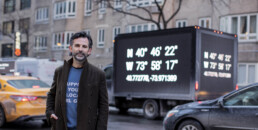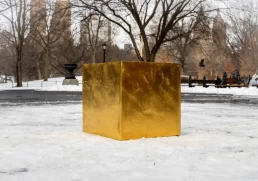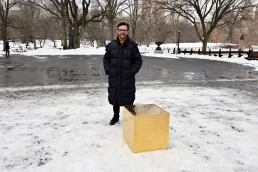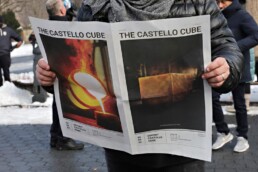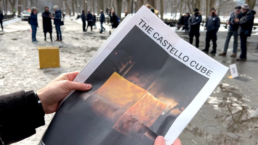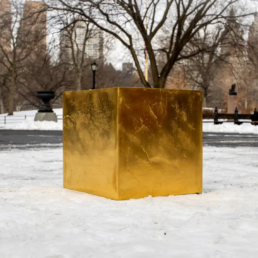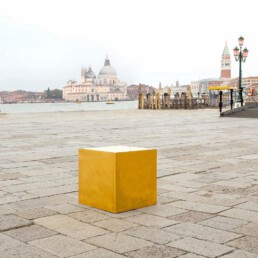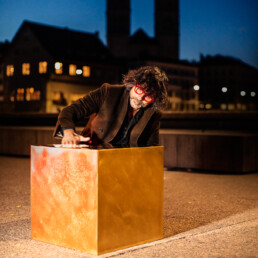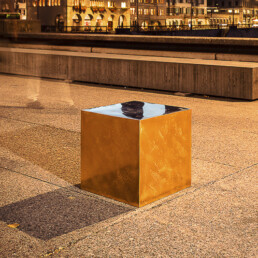Work
The Cube
Year2022ExhibitionsNew York (2022)
Venice (2022)
Zürich (2022)
The Castello Cube is a conceptual work of art in all its facets. The idea manifests itself in the golden cube - the most elemen- tary geometric shape - whose image is nevertheless impossible to grasp.Castello‘s thought to let the Cube always stand alone and with direct connection to the earth carries the essential meaning.With the Castello Cube, artist Niclas Castello has managed to develop a new, incomparable kind of fascination for the shining precious metal and inspires people, art lovers as well as critics not only with the impressive appearance, but also with its unique manufacturing process, the extraordinary philoso- phical meaning and its unsaleability.The gold cube, cast from the purest gold that can be produced today, with exact razor-sharp edges and 0,248inch wall thick- ness, thus opens up a new space for discourse.
"The Castello CUBE will never be sold or owned. The artist will make no money from the work. This might make it that special thing: Something to be di- splayed and pointed at as the locus of things intrinsic to art."- Pulitzer Prize Winner Jerry Saltz
"It is the melted down Golden Calf reduced to its most elemental form and transformed into the pedestal of our globe."- Dr. Dieter Burchhart
While no one in history had ever incorporated such a large amount of 24 carat 999.9 gold into a work of art, Castello managed to turn his groundbreaking vision into reality in January 2022, despite highly complex work processes that he had never gone through before.
Jerry Saltz | Photo: Marvin Orellana/New York Magazine
Art may be the most advanced operating system our species has ever invented to explore consciousness, the seen, and unseen worlds. It has never not been with us. Most artists say they don’t really know where their art came from. Bob Dylan said, “It’s like a ghost is writing – except the ghost picked me.” Cindy Sherman said, “I'm really just using the mirror to summon something I don't even know until I see it.” Maybe art is using us to replicate itself. Art is an open set. It includes cave paintings, pictures inside Egyptian sarcophagi meant to be seen only by the gods of the afterlife, fertility and voodoo figures, all the way Duchamp’s 1917 Fountain, a urinal turned on its side, signed “R. Mutt,” and placed on a pedestal, and called art. Fountain is an unbegotten work, a kind of virgin birth, cosmic coitus of imagination and intellect, something found, redisplayed - pointed at as the locus of something intrinsic to art. In the 1960s Donald Judd created boxes and cubes that were manufactured by machines to his specifications. Art requires leap of faiths and accepting that objects can form new thought structures. This is why art requires doubt our best measure for testing and learning things.
Now comes Niclas Castello’s hollow cube of 24 carat of gold. Castello Cube, as it is titled, measures around 19,685x19,685x19,685 inches; the walls are thin, about a quarter inch thick. It’s heavy, over 400 pounds. Now for what you really want to know: All totaled with material and over 4,500 hours of production, the thing cost $12,200,200 to make. These days art is big business, glitzy, glamorous and obscene in some of its. Thus, it is partly an envy-based economy. This is fine. Who wouldn’t want that kind of money. This only tells us that envy, being agog over price, anger, being offended, covetous, skeptical, and confused are all part of the deep content or inner qualities of Castell’s Cube. So, may be is the inclusion of his name in the title. All this is simply part of the whole ball of wax we use in trying to ascertain this, or any work of art.
Castello Cube is never to be displayed on a pedestal, and only on the ground, and here, in public. The idea of this much gold, in this place, sitting on the ground, looking defenseless, smaller than we might think, works a strange magic on us. WE are at once put-off, attracted, unsure, as we sense all this as an uncanny byproduct. Moreover, public monuments are now the subject of enormous current pressure: Many are torn down, covered by graffiti, and much more.
More than its form, a cube or box – a subject we know well in art over the last 60 years of Minimalism – it is the material that centers this object. Gold. Primal, ancient, with nearly the strange power, sense of singleness, and meaning of art. It is a genre unto itself between science, theater, sight, touch, temperature, mysticism, metaphysics, mythology, catharsis, sensuousness, psychology, and alchemy. Gold and humans seem almost to have evolved together. Halos are gold; gold is the color of the soul. Wedding rings are gold; gold is love, fidelity, faith, forever. In addition to Aztec Gods of sacrifice, the exiles in Sinai forged the Golden Calf to worship. Gold is the color of idolatry. To us, most of all, gold is power. Conquistadors triggered the deaths of as many 100,000,000 people in the Americas. The search for gold represents death. Gold makes “might equal right” even though we all know that this is wrong. Gold is contradiction, a kind of prime number divisible only by itself. It’s color mesmerizes, dazzles, makes us feel fever. The Golden Rule withers in the face of all this.By now, all these essences have been reduced in the 21st century into only one thing. Money. Gold is good, not beauty. Castello Cube makes us aware of this. Each who peers at Castello’s work must ask if all of these deep qualities and content transcend enough to become art? Castello Cube wants to have a double presence: It wants to be an art object in itself, and, at the same time, an art object that makes us ask what art is. I have only one more piece of essential content that might help you ascertain what Castello Cube might be and if it contains love, generosity, bravery, and other forms of beauty. Castello Cube will never be sold or owned. The artist will make no money from the work. This might make it that special thing: Something to be displayed and pointed at as the locus of things intrinsic to art.
Jerry Saltz
Art may be the most advanced operating system our species has ever invented to explore consciousness, the seen, and unseen worlds. It has never not been with us. Most artists say they don’t really know where their art came from. Bob Dylan said, “It’s like a ghost is writing – except the ghost picked me.” Cindy Sherman said, “I'm really just using the mirror to summon something I don't even know until I see it.” Maybe art is using us to replicate itself. Art is an open set. It includes cave paintings, pictures inside Egyptian sarcophagi meant to be seen only by the gods of the afterlife, fertility and voodoo figures, all the way Duchamp’s 1917 Fountain, a urinal turned on its side, signed “R. Mutt,” and placed on a pedestal, and called art. Fountain is an unbegotten work, a kind of virgin birth, cosmic coitus of imagination and intellect, something found, redisplayed - pointed at as the locus of something intrinsic to art. In the 1960s Donald Judd created boxes and cubes that were manufactured by machines to his specifications. Art requires leap of faiths and accepting that objects can form new thought structures. This is why art requires doubt our best measure for testing and learning things.
Now comes Niclas Castello’s hollow cube of 24 carat of gold. Castello Cube, as it is titled, measures around 19,685x19,685x19,685 inches; the walls are thin, about a quarter inch thick. It’s heavy, over 400 pounds. Now for what you really want to know: All totaled with material and over 4,500 hours of production, the thing cost $12,200,200 to make. These days art is big business, glitzy, glamorous and obscene in some of its. Thus, it is partly an envy-based economy. This is fine. Who wouldn’t want that kind of money. This only tells us that envy, being agog over price, anger, being offended, covetous, skeptical, and confused are all part of the deep content or inner qualities of Castell’s Cube. So, may be is the inclusion of his name in the title. All this is simply part of the whole ball of wax we use in trying to ascertain this, or any work of art.
Castello Cube is never to be displayed on a pedestal, and only on the ground, and here, in public. The idea of this much gold, in this place, sitting on the ground, looking defenseless, smaller than we might think, works a strange magic on us. WE are at once put-off, attracted, unsure, as we sense all this as an uncanny byproduct. Moreover, public monuments are now the subject of enormous current pressure: Many are torn down, covered by graffiti, and much more.
More than its form, a cube or box – a subject we know well in art over the last 60 years of Minimalism – it is the material that centers this object. Gold. Primal, ancient, with nearly the strange power, sense of singleness, and meaning of art. It is a genre unto itself between science, theater, sight, touch, temperature, mysticism, metaphysics, mythology, catharsis, sensuousness, psychology, and alchemy. Gold and humans seem almost to have evolved together. Halos are gold; gold is the color of the soul. Wedding rings are gold; gold is love, fidelity, faith, forever. In addition to Aztec Gods of sacrifice, the exiles in Sinai forged the Golden Calf to worship. Gold is the color of idolatry. To us, most of all, gold is power. Conquistadors triggered the deaths of as many 100,000,000 people in the Americas. The search for gold represents death. Gold makes “might equal right” even though we all know that this is wrong. Gold is contradiction, a kind of prime number divisible only by itself. It’s color mesmerizes, dazzles, makes us feel fever. The Golden Rule withers in the face of all this.By now, all these essences have been reduced in the 21st century into only one thing. Money. Gold is good, not beauty. Castello Cube makes us aware of this. Each who peers at Castello’s work must ask if all of these deep qualities and content transcend enough to become art? Castello Cube wants to have a double presence: It wants to be an art object in itself, and, at the same time, an art object that makes us ask what art is. I have only one more piece of essential content that might help you ascertain what Castello Cube might be and if it contains love, generosity, bravery, and other forms of beauty. Castello Cube will never be sold or owned. The artist will make no money from the work. This might make it that special thing: Something to be displayed and pointed at as the locus of things intrinsic to art.
Jerry Saltz
